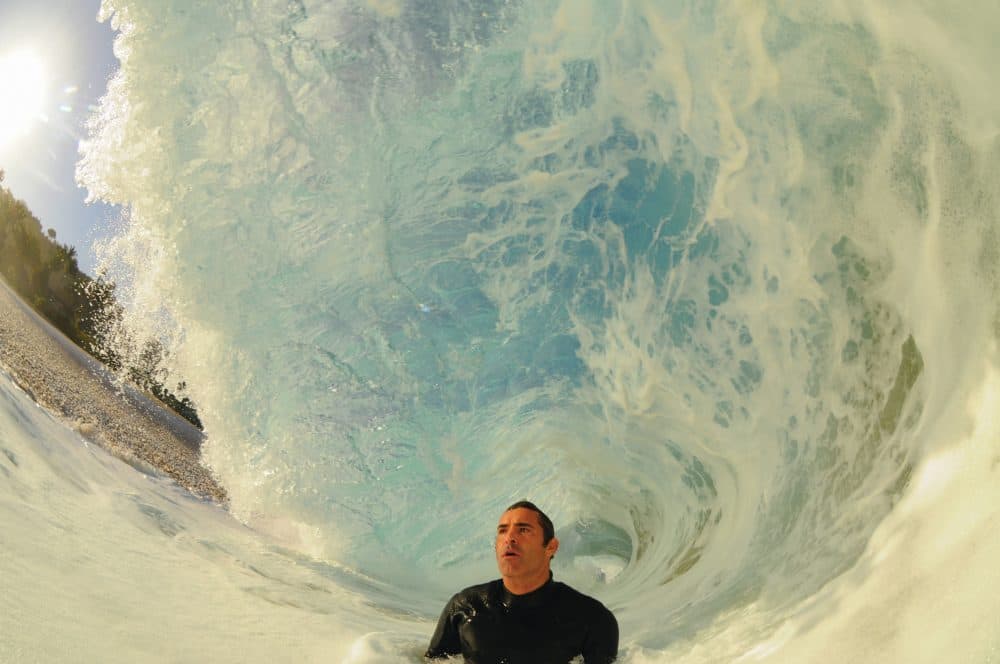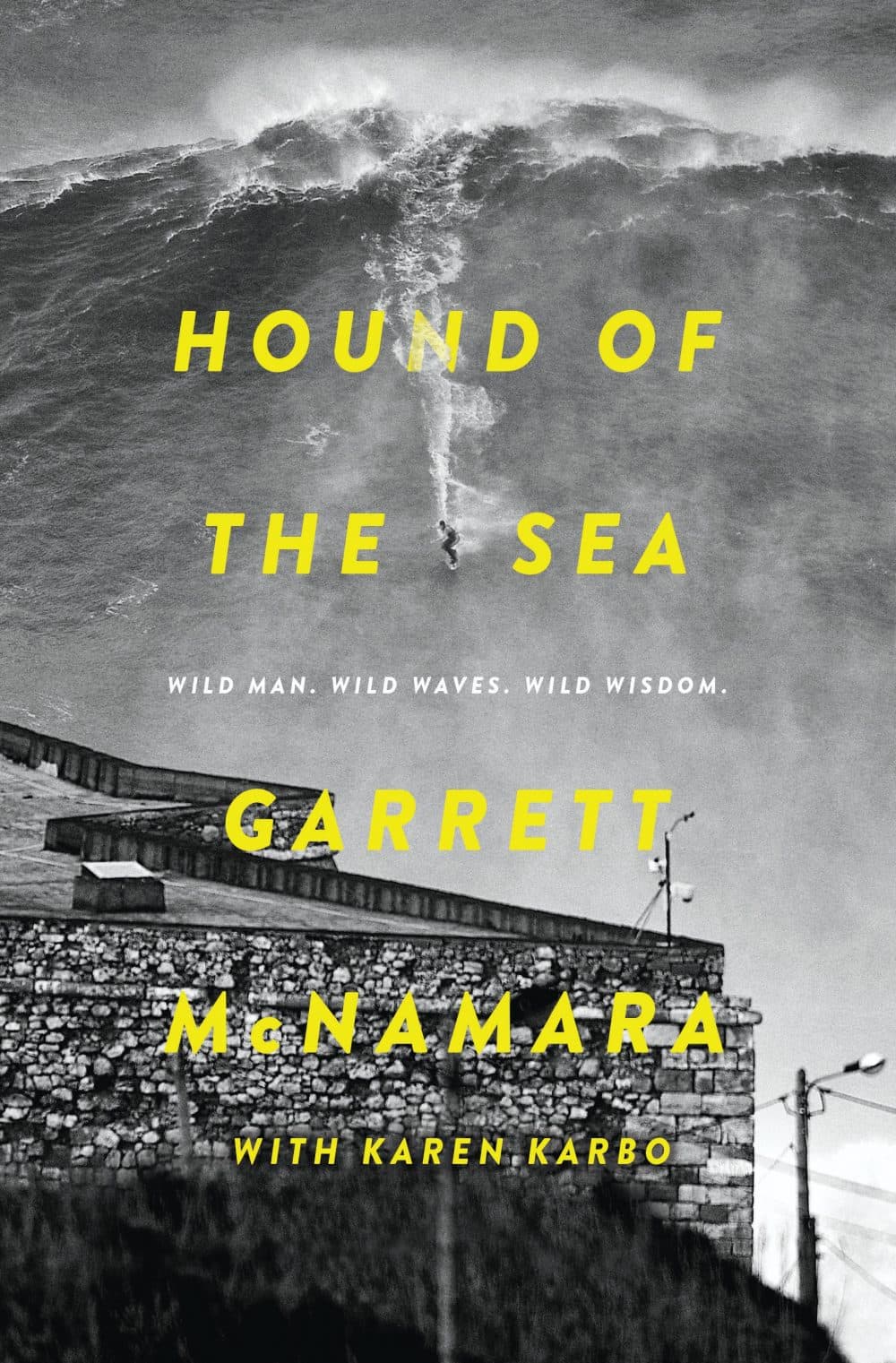Advertisement
How Garrett McNamara Found His Dharma On A Surfboard

“Dharma.” It’s a Sanskrit word that has more than one meaning. But however it’s defined, there’s an implication; the idea that every person has a path he or she must follow.
When you ask 49-year-old pro athlete Garrett McNamara for his definition, he struggles a bit.
"Dharma. It’s just…ahhhh, that’s a great question. Dharma is just…I don’t know. That’s a tough one for me right now," McNamara says.
But when you ask McNamara how dharma led him to his passion and lifted him perhaps higher than any athlete in his sport, he doesn’t struggle at all.
Finding The Right Board
Garrett McNamara loved skateboarding with his friends in Berkeley, Calif. But in the late '70s, when he was just 11 years old, that all went away.
"My mother married this guy, his name was Darryl. And he was moving us to Hawaii. And he was a musician. He was working with Don Ho’s daughter, actually," McNamara says. "And then he ended up meeting some girl, left my mom, and me and my mother and brother were stuck in Waialua at Cement City. It was pretty much the armpit of Oahu."
McNamara and his family went on welfare. They lived on macaroni and cheese and Frosted Flakes. “We had nothing,” he says. Not even skateboards. But then the dharma kicked in.
"I don’t remember where the surfboard came from. I think at a garage sale, or we found it in the bushes. But we got the board and that was it," McNamara says. "The first time I tried surfing, we went out in front of Cement City and I just remember falling in love. It just instantly became all I wanted to do. It’s just the most amazing feeling to be out there in the water riding waves. It’s like walking on the water.
Advertisement
"Nothing mattered. Nothing mattered. If you have the ocean and you have your board, nothing matters."
McNamara began to master the technically challenging small waves of Oahu’s north shore. But his growing obsession presented a problem.
"In Hawaii, you got two choices: you go left to the beach, the most amazing fun of your life, or go right to school. I went left a lot," McNamara says. "When I was 17, I was getting ready to graduate from high school. I had Cs, Ds and Fs. And I was so afraid of the world. So afraid of what I was gonna do. Am I gonna have to be a waiter? Am I gonna have to be a carpenter? What am I gonna do when I get out of school? 'Man, maybe I should just try and flunk.' I really contemplated this. I’ll flunk, and I’ll stay in school another year, so I have another year to figure it out."
Turning Pro
McNamara didn’t have to figure for very long. He entered a contest in the Hawaiian Triple Crown Series where he’d compete against the world’s greatest surfers on waves larger than he was used to. He didn’t win it, but he did make it to the main event, and into the money.
"So, I gladly accepted the $250, and all of a sudden, 'Wow! I’m a pro surfer! OK!' So, I went to school a lot more, and made sure I passed, graduated, and I’ve been a professional surfer ever since," McNamara says. "Once I became pro, it was such a relief. 'Wow, I get to do what I love to do.'"
For the next few years, he competed on the pro circuit. His travels brought him to Japan, where he was a celebrity. He made good money in competitions, appeared on the covers of the big surfing magazines and racked up endorsement deals. He was a surfing success by every measure.
"I felt like I was as good or better than anybody. I thought I was invincible. I thought I could conquer any wave, ride any wave, survive anything," McNamara says.
A Major Setback
It was 1989. McNamara was one of 28 surfers invited to compete in The Eddie, a big wave tournament in Oahu scheduled each year from December to February. It doesn’t go on if the waves aren’t at least 40 feet high. Most years, it doesn’t even happen. But on January 28, 1990, he and 27 other surfers got the call that the contest was on.
"And the next day, the swell of the year is coming, and the biggest set of the day comes. And I take off in a perfect spot, and I stood up all confident, like 'Yeah, I got this. I’m conquering this wave,' is kinda what I’m thinking. It just flings me in the air, and I land in the flats on the bottom, and I look up and I see the biggest barrel ever come over me, and then I land right on the tail of the surfboard. And I didn’t realize it as I hit, but it kinda just gave me kind of a punch in the ribs," McNamara says.
"And now I’m underwater getting pounded. And I’m actually really happy and having a great time. And I come up all excited and ready to go back for more. And all of a sudden I’m paddling out and I start coughing up blood. And I found out I had broken a rib, herniated my disc. I was on the floor for four months, and all the sponsors I had gained ended up dropping my salary or dropping me altogether. And so it really humbled me. I didn’t see much of a career ever resurfacing," he says.
McNamara was just 22. For the next two years, he lived in constant pain. But he says he’s lucky. His back healed completely. In 1992, he returned to the water and focused once more on small wave tournaments. He made a respectable, if unsteady, living.
He married in 1994. He and his wife Connie became parents the next year. McNamara opened a surf shop in Oahu to help support his family. He struggled with the idea of having one foot on his surfboard, and one in the shop.
"So now I was at a crossroad," he says. "I thought, 'Why am I doing this?'"
Discovering His Dharma
Over the next six years, McNamara didn’t surf very much. During long days indoors, he daydreamed. He’d scribble inspirational notes in his business log and gaze longingly at the ocean on his drive to work. But at the age of 35, he entered and trained for the 2002 Pe’ahi Challenge on Maui, also known as “Jaws” for its dangerous 70-foot waves.
"When I jump in the water, all of a sudden, it’s Dharma," he says. "The place that you feel you’re supposed to be and so fun and so amazing, so enjoyable, and all of a sudden you’re a little kid again. And you go, 'How could I ever have thought that I didn’t need this?'"
McNamara won the contest and pocketed the $70,000 first prize. He closed the shop and focused on “tow-in” surfing, where Jet Skis pull surfers to the peaks of fast-moving big waves. He wanted his name associated with the monster waves, the heaviest of the heavy. McNamara and his second wife, Nicole, were invited to the Portuguese coastal town of Nazaré, which some believe has the biggest waves in the world.
"When we arrived in Nazaré, we walked up to the cliff, and I saw the biggest waves I’ve ever seen in my life. It was like the “Tah-dah" moment. I mean, I looked and just went 'Oh, my God,'" McNamara says.
Catching The Big One
McNamara and his wife stayed in Nazaré for months, getting to know the surf and the people. At 11 o'clock on the 11th day of the 11th month of 2011, the waves got bigger. He got into the water with a team of Jet Skiers.

"My wife, we hear her on the walkie-talkie. 'There’s a big set coming!' And I look, and the whole horizon stands. And there’s this monster, this massive wall. And I’m fading back, and I’m looking at all the chops, and I’m looking at the cliff, and I’m looking down the line towards the end of the wave. As I’m going to the bottom, there are all these chops coming up the wave. And usually the chops at Nazaré are really violent and massive, and your board hits them so hard. Usually it’s like “Bah! Bah! Bah!” And this one was like “Tgh-tgh-tgh-tgh…” Just smooth and perfect," McNamara says.
At the end of his ride, McNamara was buried by the wave. But he’d been buried before.
"So it wasn’t like anything that I thought was out of the ordinary," he says with a laugh.
But it was.
"We go to the harbor, and they come running down with the pictures, and we look at it. And we were just like 'Woah.' And a panel of surfers measures the waves and, surprisingly, they measured it at 78 feet and gave me the world record," McNamara says.
In 2013, he again caught a monster wave in Nazaré. Not to break his own Guinness record. Just for fun. That wave was estimated at 100 feet. There’s still disagreement about its size. And another surfer may have gone even higher at Nazaré. But Garrett McNamara says that it just doesn’t matter to him.
"It was about going out there for the right reasons, going out there for the love of it. And just not expecting anything in return, and everything just comes together. Dharma," he says with a laugh.
Learn more about Garrett McNamara's surfing career in his book Hound of the Sea.
This segment aired on January 28, 2017.
